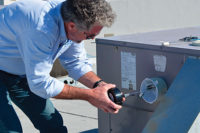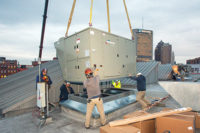The phrase “out of sight, out of mind” may as cliché as the day is long, but when HVAC contractors were asked to share their maintenance tips for rooftop units, the overused expression popped up again and again as they described how most building owners treat their rooftop HVAC equipment.
Of course, not servicing that important equipment — or servicing it improperly — can lead to big problems later on for both the building owner and the contractor. Here are a few useful tips from contractors, to contractors, for servicing and maintaining rooftop units.
Maintenance is Key
“When I think about rooftops, I think of lack of maintenance for that unappreciated soldier sitting up on the roof, all by himself, until he breaks,” said Steve Moon, owner of Moon Air Inc., Elkton, Md.
Moon said performing routine preventive maintenance is the only way to keep rooftop units in the best possible condition, though convincing building owners to pay for that service isn’t always easy.
“The downfall is that packaged units are typically the easiest ones to service, but they get the least amount of service because they’re out of sight,” he continued. “It’s up there, and as long as it’s working, they don’t want to know about it. They don’t want to poke the bear.”
The solution, Moon said, is consumer education. “I think the biggest part of rooftop maintenance is making the customer aware of how important it is,” Moon explained. “I say, ‘If you maintain it, it costs this, and if you don’t maintain it, this is what it could cost you.’”
“The biggest tip is to find clients who are willing to spend the money for a mechanic to do a proper inspection, not a fly by,” said Ronald Sage, vice president of Westside Mechanical Inc., Naperville, Ill., on The NEWS’ LinkedIn page. “If it’s a 130-ton VAV [variable-air volume] RTU [rooftop unit], with an ERV [energy recovery ventilator], Aaon, or a little 5-ton RTU, they all have specific requirements. Each task takes time for a mechanic to do.”
Daniel Schmaus, owner of Vashon Heating & Cooling, Vashon, Wash., said a lack of service education hurts both the consumer and HVACR contractors, who may lose business to other companies willing to do subpar work at lower prices.
“I have lost accounts because other companies are either not doing the work needed or are giving the service away hoping to get the money back on repairs,” Schmaus said. “How do you counter that?”
Location, Location, Location
A simple way to ensure rooftop units are operating as efficiently as possible is to make sure the surface they are sitting on is helping, not hindering, the unit’s efficiency.
“I have seen the ambient temperature well over 120˚F here in Florida on the roof because of the color of the roof being black,” said Chris Johnson, HVAC sales consultant at Tropic Supply Inc., Sunrise, Fla., on The NEWS’ LinkedIn page. “This causes many premature failures that could be prevented if the roof around the rooftop unit is cool sealed with a light-colored coating. Remember design temperature is 95˚ — talk about capacity loss.”
Additionally, units that have an economizer, that are situated on a dark rooftop, can become even less efficient if the economizer is not in good working order, which Michael Duffin, vice president of Aire Design Systems Inc., Carrollton, Texas, said is a common problem.
“I find economizers often not working properly,” Duffin said on The NEWS’ LinkedIn page. “(It’s) a source of free cooling but can work against the cooling mode when the OSA is full open on a roof at 100˚ or hotter on the roof.”
Change Filters, Belts Regularly
Dean Thomasson, president and CEO of HouseCallCompany.com, Portsmouth, Va., said his technicians change out filters every season and encourage building owners or tenants to change the air filters inside the building between services.
“If we filter at the point of entry and encourage our clients to change the filter every 30 days, and then we go up into the rooftop unit and install two one-inch filters — that’s all it needs,” Thomasson said.
“I think we always need to filter at the point of entry because we don’t want dirt to get into the ductwork, ever. We take the filter in the front out and put a new one behind it, and there isn’t any excess resistance.”
Ann Kahn, owner of Kahn Mechanical Contractors, Dallas, agreed that changing the air filters and belt regularly is essential.
“In addition to pleated filters and thorough coil cleaning, we always recommend an annual belt change,” she said. “This is a relatively inexpensive item that saves emergency down time that usually happens on the hottest day of the year.”
Kahn also recommends buying two belts and leaving one inside the unit, just in case.
Keep the Coil Clean
To help keep a unit running in peak condition, many contractors recommended cleaning the condensing coil on every visit.
“Soap and water is your best friend, and if you do it regularly, it’s all you need,” Moon said. “If additional work is necessary, we use the standard condensing coil and evaporator cleaner.”
Mark Norenberg, general manager, Air Comfort of KY Inc., Louisville, Ky., admitted that cleaning evaporator coils usually entails extra work, though he said it is necessary.
“RTUs need the same attention as any system that sits on the ground,” Norenberg said. “It’s a lot more work to drag all the tools and testing equipment up there, plus there is never a hose bib on the roof, so coil cleaning with water is an even a greater challenge.
“You have to allow additional time for all of this which does two things: It makes these tune-ups more expensive, and the tech may be tempted to take shortcuts,” he said. “Get past these and you can build a commercial base of preventive-maintenance customers, just like your residential group.”
Consider UV
In addition to using recommended cleaners, ultraviolet (UV) lights can also be installed on units to help keep the coil clean between scheduled maintenance visits.
“UV lights are going to help with molds and things like that,” Moon said, adding that they are not meant to work on dirt.
Thomasson agreed that UV lights do offer certain benefits, though installation can be harder if the unit wasn’t designed to facilitate a UV light. “You need to evaluate it on a case-by-case basis,” he said. “You can’t always put it in every packaged unit.”
Forrest Fencl, president of UV Resources, Santa Clarita, Calif., said UV can save both time and money when installed in certain rooftop units. “There are so many rooftop units out there — literally millions of them,” Fencl said, adding that 3-5 percent of those units include some sort of UV light. “When you work it out and a technician is charging $85 per hour or more, UV becomes pretty inexpensive because you don’t have to pay as much for the maintenance on the coil.”
Fencl likened UV to bleach when it comes to keeping a coil clean. “They don’t work in exactly the same way, but they have pretty close to the same result,” he said. He added that many contractors don’t even consider UV when they encounter a moldy coil, which he hopes to change through education.
“If we had enough contractors who were serious about this, we’d definitely consider putting together webinars,” Fencl said.
Don’t Take Shortcuts
Most importantly, contractors agree that taking shortcuts when it comes to servicing a rooftop unit will only spell disaster down the line.
“It comes much lower on the customers’ priority list, and most HVAC technicians hate to do maintenance,” Moon admitted. “They don’t look at it in the correct light as it’s really offering the customer a terrific service.”
Thomasson agreed that technicians may not always enjoy performing maintenance, but doing it properly each and every time is the only option. “We tell our guys all the time, you may not like it, but the days of showing up and being successful are gone,” he said. Thomasson added that, when in doubt, there are numerous resources available for technicians.
“You have to be in pursuit of knowledge,” Thomasson said. It’s not a choice anymore.”
Marc Newman, owner of Standard Refrigerators Inc., Long Island City, N.Y., agreed and recommended utilizing ASHRAE Standard 180 — Standard Practice for Inspection and Maintenance of Commercial Building HVAC Systems.
“This document provides check-lists for RTU maintenance tasks that technicians should be performing,” Newman said on The NEWS’ LinkedIn page. “It is now part of the International Mechanical Code, which, when cited in local building codes, automatically requires owners to perform preventive maintenance under the code.”
Thomasson stressed the importance of doing due diligence while performing maintenance, which includes listening to customers, educating them, and avoiding all shortcuts when performing maintenance. “You have to treat each situation you go to as unique,” he said. “Do proper evaluations, open your eyes, and find out what the client really needs. When you’ve done that, this is when you’ve earned the right to gain their business.”
Publication date: 6/17/2013
Want more HVAC industry news and information? Join The NEWS on Facebook, Twitter, and LinkedIn today!








Report Abusive Comment